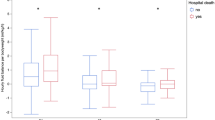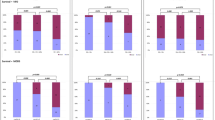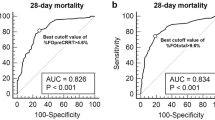Abstract
Purpose
In pediatric intensive care unit (PICU) patients, fluid overload (FO) at initiation of continuous renal replacement therapy (CRRT) has been reported to be an independent risk factor for mortality. Previous studies have calculated FO based on daily fluid balance during ICU admission, which is labor intensive and error prone. We hypothesized that a weight-based definition of FO at CRRT initiation would correlate with the fluid balance method and prove predictive of outcome.
Methods
This is a retrospective single-center review of PICU patients requiring CRRT from July 2006 through February 2010 (n = 113). We compared the degree of FO at CRRT initiation using the standard fluid balance method versus methods based on patient weight changes assessed by both univariate and multivariate analyses.
Results
The degree of fluid overload at CRRT initiation was significantly greater in nonsurvivors, irrespective of which method was used. The univariate odds ratio for PICU mortality per 1% increase in FO was 1.056 [95% confidence interval (CI) 1.025, 1.087] by the fluid balance method, 1.044 (95% CI 1.019, 1.069) by the weight-based method using PICU admission weight, and 1.045 (95% CI 1.022, 1.07) by the weight-based method using hospital admission weight. On multivariate analyses, all three methods approached significance in predicting PICU survival.
Conclusions
Our findings suggest that weight-based definitions of FO are useful in defining FO at CRRT initiation and are associated with increased mortality in a broad PICU patient population. This study provides evidence for a more practical weight-based definition of FO that can be used at the bedside.
Similar content being viewed by others
References
Bunchman TE, McBryde KD, Mottes TE, Gardner JJ, Maxvold NJ, Brophy PD (2001) Pediatric acute renal failure: outcome by modality and disease. Pediatr Nephrol 16:1067–1071
Bresolin N, Silva C, Halllal A, Toporovski J, Fernandes V, Goes J, Carvalho FL (2009) Prognosis for children with acute kidney injury in the intensive care unit. Pediatr Nephrol 24:537–544
Fernandez C, Lopez-Herce J, Flores JC, Galaviz D, Ruperez M, Brandstrup KB, Bustinza A (2005) Prognosis in critically ill children requiring continuous renal replacement therapy. Pediatr Nephrol 20:1473–1477
Schneider J, Khemani R, Grushkin C, Bart R (2010) Serum creatinine as stratified in the RIFLE score for acute kidney injury is associated with mortality and length of stay for children in the pediatric intensive care unit. Crit Care Med 38:933–939
Plotz FB, Bouma AB, van Wijk JA, Kneyber MC, Bokenkamp A (2008) Pediatric acute kidney injury in the ICU: an independent evaluation of pRIFLE criteria. Intensive Care Med 34:1713–1717
Warady BA, Bunchman T (2000) Dialysis therapy for children with acute renal failure: survey results. Pediatr Nephrol 15:11–13
Brophy PD (2008) Renal supportive therapy for pediatric acute kidney injury in the setting of multiorgan dysfunction syndrome/sepsis. Semin Nephrol 28:457–469
Goldstein SL (2009) Overview of pediatric renal replacement therapy in acute kidney injury. Semin Dial 22:180–184
Flores FX, Brophy PD, Symons JM, Fortenberry JD, Chua AN, Alexander SR, Mahan JD, Bunchman TE, Blowey D, Somers MJ, Baum M, Hackbarth R, Chand D, McBryde K, Benfield M, Goldstein SL (2008) Continuous renal replacement therapy (CRRT) after stem cell transplantation. A report from the prospective pediatric CRRT Registry Group. Pediatr Nephrol 23:625–630
Michael M, Kuehnle I, Goldstein SL (2004) Fluid overload and acute renal failure in pediatric stem cell transplant patients. Pediatr Nephrol 19:91–95
Lane PH, Mauer SM, Blazar BR, Ramsay NK, Kashtan CE (1994) Outcome of dialysis for acute renal failure in pediatric bone marrow transplant patients. Bone Marrow Transplant 13:613–617
Sutherland SM, Zappitelli M, Alexander SR, Chua AN, Brophy PD, Bunchman TE, Hackbarth R, Somers MJ, Baum M, Symons JM, Flores FX, Benfield M, Askenazi D, Chand D, Fortenberry JD, Mahan JD, McBryde K, Blowey D, Goldstein SL (2010) Fluid overload and mortality in children receiving continuous renal replacement therapy: the prospective pediatric continuous renal replacement therapy registry. Am J Kidney Dis 55:316–325
Hayes LW, Oster RA, Tofil NM, Tolwani AJ (2009) Outcomes of critically ill children requiring continuous renal replacement therapy. J Crit Care 24:394–400
Gillespie RS, Seidel K, Symons JM (2004) Effect of fluid overload and dose of replacement fluid on survival in hemofiltration. Pediatr Nephrol 19:1394–1399
Foland JA, Fortenberry JD, Warshaw BL, Pettignano R, Merritt RK, Heard ML, Rogers K, Reid C, Tanner AJ, Easley KA (2004) Fluid overload before continuous hemofiltration and survival in critically ill children: a retrospective analysis. Crit Care Med 32:1771–1776
Goldstein SL, Currier H, Graf C, Cosio CC, Brewer ED, Sachdeva R (2001) Outcome in children receiving continuous venovenous hemofiltration. Pediatrics 107:1309–1312
Goldstein SL, Somers MJ, Baum MA, Symons JM, Brophy PD, Blowey D, Bunchman TE, Baker C, Mottes T, McAfee N, Barnett J, Morrison G, Rogers K, Fortenberry JD (2005) Pediatric patients with multi-organ dysfunction syndrome receiving continuous renal replacement therapy. Kidney Int 67:653–658
Brierley J, Carcillo JA, Choong K, Cornell T, Decaen A, Deymann A, Doctor A, Davis A, Duff J, Dugas MA, Duncan A, Evans B, Feldman J, Felmet K, Fisher G, Frankel L, Jeffries H, Greenwald B, Gutierrez J, Hall M, Han YY, Hanson J, Hazelzet J, Hernan L, Kiff J, Kissoon N, Kon A, Irazuzta J, Lin J, Lorts A, Mariscalco M, Mehta R, Nadel S, Nguyen T, Nicholson C, Peters M, Okhuysen-Cawley R, Poulton T, Relves M, Rodriguez A, Rozenfeld R, Schnitzler E, Shanley T, Kache S, Skippen P, Torres A, von Dessauer B, Weingarten J, Yeh T, Zaritsky A, Stojadinovic B, Zimmerman J, Zuckerberg A (2009) Clinical practice parameters for hemodynamic support of pediatric and neonatal septic shock: 2007 update from the American College of Critical Care Medicine. Crit Care Med 37:666–688
Rivers E, Nguyen B, Havstad S, Ressler J, Muzzin A, Knoblich B, Peterson E, Tomlanovich M (2001) Early goal-directed therapy in the treatment of severe sepsis and septic shock. N Engl J Med 345:1368–1377
Wiedemann HP, Wheeler AP, Bernard GR, Thompson BT, Hayden D, de Boisblanc B, Connors AF Jr, Hite RD, Harabin AL (2006) Comparison of two fluid-management strategies in acute lung injury. N Engl J Med 354:2564–2575
Upadya A, Tilluckdharry L, Muralidharan V, Amoateng-Adjepong Y, Manthous CA (2005) Fluid balance and weaning outcomes. Intensive Care Med 31:1643–1647
Payen D, de Pont AC, Sakr Y, Spies C, Reinhart K, Vincent JL (2008) A positive fluid balance is associated with a worse outcome in patients with acute renal failure. Crit Care 12:R74
Prowle JR, Echeverri JE, Ligabo EV, Ronco C, Bellomo R (2010) Fluid balance and acute kidney injury. Nat Rev Nephrol 6:107–115
Cerda J, Sheinfeld G, Ronco C (2010) Fluid overload in critically ill patients with acute kidney injury. Blood Purif 29:331–338
Antonelli M, Azoulay E, Bonten M, Chastre J, Citerio G, Conti G, De Backer D, Lemaire F, Gerlach H, Groeneveld J, Hedenstierna G, Macrae D, Mancebo J, Maggiore SM, Mebazaa A, Metnitz P, Pugin J, Wernerman J, Zhang H (2009) Year in review in Intensive Care Medicine, 2008: I. Brain injury and neurology, renal failure and endocrinology, metabolism and nutrition, sepsis, infections and pneumonia. Intensive Care Med 35:30–44
Bunchman TE, Maxvold NJ, Barnett J, Hutchings A, Benfield MR (2002) Pediatric hemofiltration: Normocarb dialysate solution with citrate anticoagulation. Pediatr Nephrol 17:150–154
Pollack MM, Patel KM, Ruttimann UE (1996) PRISM III: an updated pediatric risk of mortality score. Crit Care Med 24:743–752
Bellomo R, Ronco C, Kellum J, Mehta R, Palevsky P (2004) Acute renal failure—definition, outcome measures, animal models, fluid therapy and information technology needs: the Second International Consensus Conference of the Acute Dialysis Quality Initiative (ADQI) Group. Crit Care 8:R204–R212
Akcan-Arikan A, Zappitelli M, Loftis L, Washburn K, Jefferson L, Goldstein S (2007) Modified RIFLE criteria in critically ill children with acute kidney injury. Kidney Int 71:1028–1035
Schwartz GJ, Brion LP, Spitzer A (1987) The use of plasma creatinine concentration for estimating glomerular filtration rate in infants, children, and adolescents. Pediatr Clin North Am 34:571–590
Levey AS, Coresh J, Greene T, Stevens LA, Zhang YL, Hendriksen S, Kusek JW, Van Lente F (2006) Using standardized serum creatinine values in the modification of diet in renal disease study equation for estimating glomerular filtration rate. Ann Intern Med 145:247–254
Eastwood GM (2006) Evaluating the reliability of recorded fluid balance to approximate body weight change in patients undergoing cardiac surgery. Heart Lung 35:27–33
Pflaum SS (1979) Investigation of intake-output as a means of assessing body fluid balance. Heart Lung 8:495–498
Mank A, Semin-Goossens A, Lelie J, Bakker P, Vos R (2003) Monitoring hyperhydration during high-dose chemotherapy: body weight or fluid balance? Acta Haematol 109:163–168
Symons JM, Brophy PD, Gregory MJ, McAfee N, Somers MJ, Bunchman TE, Goldstein SL (2003) Continuous renal replacement therapy in children up to 10 kg. Am J Kidney Dis 41:984–989
Symons JM, Chua AN, Somers MJ, Baum MA, Bunchman TE, Benfield MR, Brophy PD, Blowey D, Fortenberry JD, Chand D, Flores FX, Hackbarth R, Alexander SR, Mahan J, McBryde KD, Goldstein SL (2007) Demographic characteristics of pediatric continuous renal replacement therapy: a report of the prospective pediatric continuous renal replacement therapy registry. Clin J Am Soc Nephrol 2:732–738
Swaniker F, Kolla S, Moler F, Custer J, Grams R, Barlett R, Hirschl R (2000) Extracorporeal life support outcome for 128 pediatric patients with respiratory failure. J Pediatr Surg 35:197–202
Paden ML, Warshaw BL, Heard ML, Fortenberry JD (2010) Recovery of renal function and survival after continuous renal replacement therapy during extracorporeal membrane oxygenation. Pediatr Crit Care Med [Epub ahead of print]
Ronco C, Giomarelli P (2010) Current and future role of ultrafiltration in CRS. Heart Fail Rev [Epub ahead of print]
Acknowledgments
David T. Selewski is supported by the Cellular and Molecular Biology in Pediatrics Training Program grant (T-32 HD007513-13). Timothy T. Cornell is supported by the Pediatric Critical Care Scientist Development Program (K12HD047349) and an individual Career Development Award (K08HD062142). Neal B. Blatt is supported by a Child Health Research Career Development Award (National Institutes of Health, K12 HD 028820 (T32 DK 065517).
Author information
Authors and Affiliations
Corresponding author
Rights and permissions
About this article
Cite this article
Selewski, D.T., Cornell, T.T., Lombel, R.M. et al. Weight-based determination of fluid overload status and mortality in pediatric intensive care unit patients requiring continuous renal replacement therapy. Intensive Care Med 37, 1166–1173 (2011). https://doi.org/10.1007/s00134-011-2231-3
Received:
Accepted:
Published:
Issue Date:
DOI: https://doi.org/10.1007/s00134-011-2231-3




